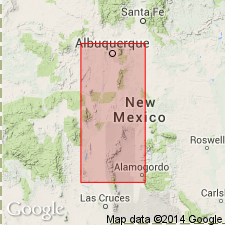
- Usage in publication:
-
- Story formation
- Modifications:
-
- Named
- Dominant lithology:
-
- Shale
- Sandstone
- Limestone
- AAPG geologic province:
-
- Orogrande basin
Summary:
Named as upper of two formations of Hansonburg group (new) of Missouri series for Story Tank, about 3 mi west of west-central front of Oscura Mountains, NM. Type locality is section measured in and near east portion of SE1/4 sec 31, T5S, R6E, northeast side of Oscura Mountains, Socorro Co, NM in Orogrande basin. Overlies Burrego formation (new) of Hansonburg; underlies Del Cuerto formation of Keller group (both new) of Virgil series. Has two distinct lithologic units: 1) lower part is composed entirely of clastics of red shale, arkosic sandstone, and gray shales--this unit has been recognized over much of central NM, including area throughout Oscura Mountains, on Little Burro Mountain in Mocking Bird Gap, in Los Pinos Mountains, near Coyote Hills, and on Cadronito Hill; and 2) upper part is composed of two massive, thick beds of light-gray limestone, separated by a thin bed of nodular to irregular limestone--recognized over a large area of central NM also. Thinnest section measured of Story is at type, where is 58.5 ft thick [text of report shows 58.5, but measured section shows 57.5 ft thick]. Upper portion highly fossiliferous. Fusulinids abundantly contained in upper 38 ft are more highly developed than are those of underlying Burrego, but are not most highly developed Missouri fusulinids known in North America--Story fusulinids resemble those found in upper part of Kansas City group of KS. Is of Pennsylvanian (Missouri) age.
Source: GNU records (USGS DDS-6; Denver GNULEX).
For more information, please contact Nancy Stamm, Geologic Names Committee Secretary.
Asterisk (*) indicates published by U.S. Geological Survey authors.
"No current usage" (†) implies that a name has been abandoned or has fallen into disuse. Former usage and, if known, replacement name given in parentheses ( ).
Slash (/) indicates name conflicts with nomenclatural guidelines (CSN, 1933; ACSN, 1961, 1970; NACSN, 1983, 2005, 2021). May be explained within brackets ([ ]).

